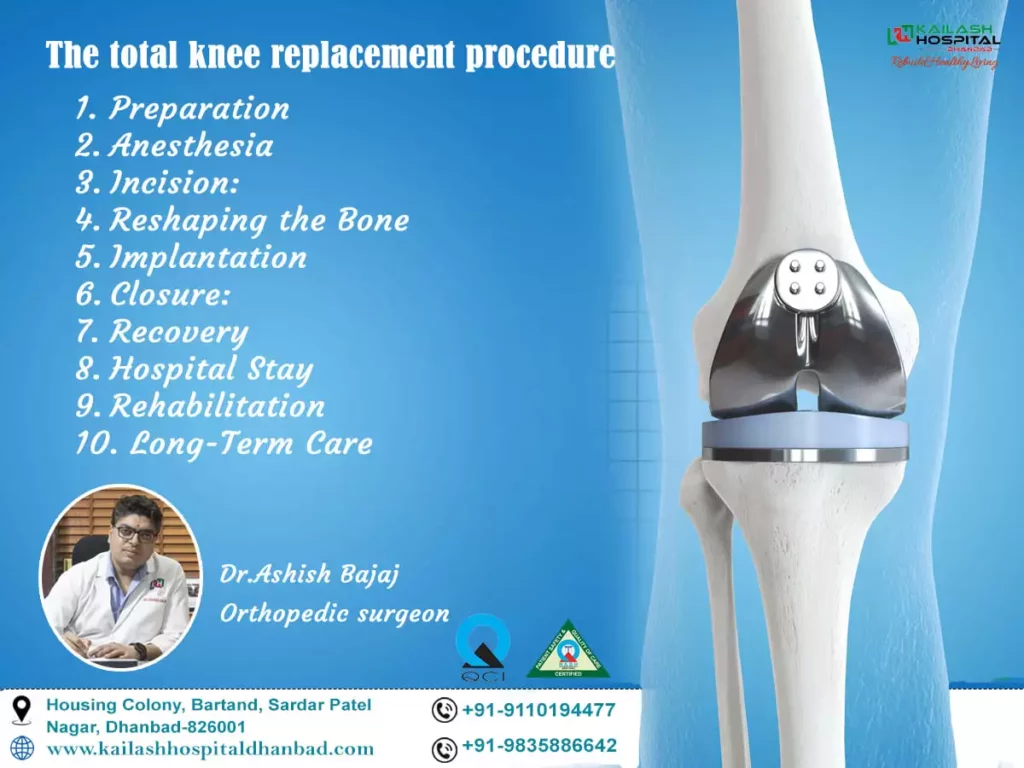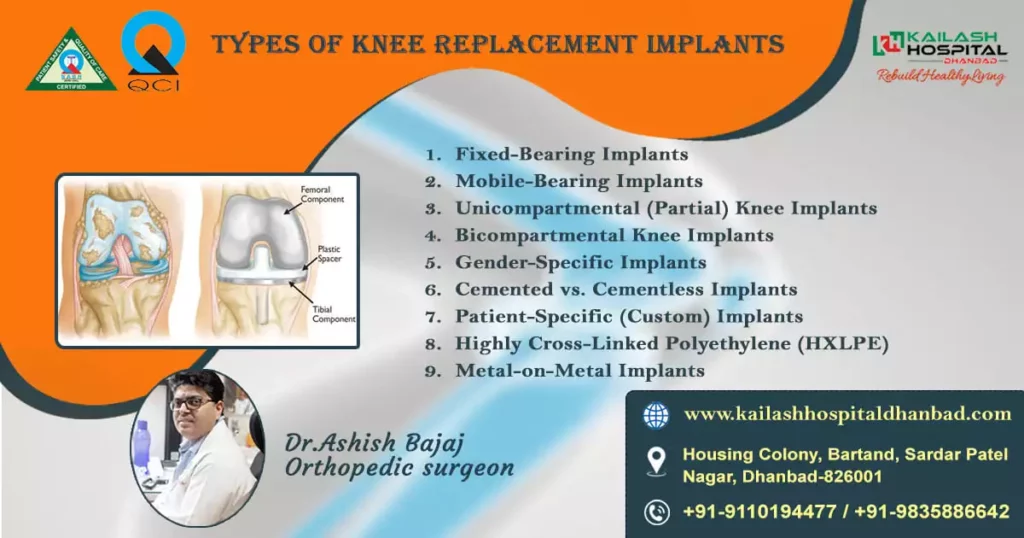
Table of Contents
Total knee replacement, also known as total knee arthroplasty (TKA), is a surgical procedure designed to relieve pain and restore function in a knee joint that has been damaged by arthritis or other conditions. Total knee replacement involves removing the damaged or diseased portions of the knee joint and replacing them with artificial components, typically made of metal and plastic.
The total knee replacement procedure is a comprehensive procedure that involves the replacement of the entire knee joint as per the followings:

- Preparation: Before the surgery, your orthopaedic surgeon will evaluate your medical history, perform a physical examination, and may order imaging tests like X-rays or MRI scans to assess the extent of damage to your knee joint. You’ll also have a discussion about the procedure, its risks, benefits, and alternatives.
- Anaesthesia: Total knee replacement is usually performed under general anaesthesia or spinal anaesthesia. Your surgeon will discuss the best option for you based on your overall health and preferences.
- Incision: The surgeon makes an incision in the front of your knee to access the joint. The size of the incision may vary depending on the specific technique used, but minimally invasive approaches are becoming more common.
- Reshaping the Bone: The damaged or arthritic surfaces of the femur (thigh bone), tibia (shin bone), and sometimes the patella (kneecap) are removed. The ends of these bones are reshaped to accommodate the artificial components.
- Implantation: The artificial knee components, which typically consist of metal and plastic, are securely attached to the reshaped bone surfaces. These components may include a metal femoral component, a metal tibial component, and a plastic spacer placed between them to create a smooth, gliding surface.
- Closure: After implantation, the surgeon closes the incision with stitches or staples and covers it with a sterile dressing.
- Recovery: You will be moved to a recovery area, where you will be monitored as you wake up from anaesthesia. Physical therapy and rehabilitation will begin shortly after surgery to help you regain strength and range of motion in your new knee joint.
- Hospital Stay: The length of your hospital stay will depend on various factors, including your overall health and the progress of your recovery. Some patients may be able to go home on the same day as the surgery, while others may require a longer stay.
- Rehabilitation: Rehabilitation and physical therapy are crucial aspects of the recovery process. You will work with a physical therapist to regain mobility, strength, and flexibility in your knee. This rehabilitation process continues for several weeks or even months after surgery.
- Long-Term Care: Total knee replacement can provide significant pain relief and improved function, but it’s important to follow your surgeon’s recommendations for long-term care. Regular follow-up appointments, exercise, and a healthy lifestyle can help ensure the success of your knee replacement.
Types of Total knee replacement implants:
There are several types of knee replacement implants, each designed to address different patient needs and anatomical considerations. The choice of implant depends on factors such as the patient’s age, activity level, overall health, and the surgeon’s preference.
Here are some common types of total knee replacement implants:
Fixed-Bearing Implants:

- These are the most commonly used knee replacement implants. They have a fixed relationship between the femoral and tibial components, meaning they do not allow for much independent movement between the two. Fixed-bearing implants can be made of various materials, including metal and plastic, and are available in different designs.
Mobile-Bearing Implants:
- Mobile-bearing implants allow for some degree of independent movement between the femoral and tibial components. This design is intended to reduce wear and tear on the implant and potentially provide more stability during movement.
Unicompartmental (Partial) Knee Implants:
- Unicompartmental knee implants are used when only one part of the knee joint is damaged, typically the medial (inner) or lateral (outer) compartment. Unlike total knee replacements, which replace all three compartments (medial, lateral, and patellofemoral), unicompartmental implants only replace the damaged portion, preserving healthy tissue.
Bicompartmental Knee Implants:
- These implants replace two of the three compartments of the knee joint, typically the medial and patellofemoral compartments. They are used when the damage is limited to these area.
Gender-Specific Implants:
- Some manufacturers offer knee implants designed specifically for male or female anatomy. These implants take into account differences in bone size, shape, and alignment that can exist between genders.
Cemented vs. Cementless Implants:
- Knee replacement implants can be fixed to the bone using bone cement (cemented) or through a process called osseointegration (cementless). Cemented implants are more common and are often used in older patients or those with weaker bone quality. Cementless implants rely on the bone growing into the implant for stability and are typically used in younger, more active patients.
Patient-Specific (Custom) Implants:
- In some cases, patient-specific knee replacement implants are designed using advanced imaging and computer modelling techniques. These implants are tailored to the patient’s unique anatomy, potentially leading to improved fit and alignment.
Highly Cross-Linked Polyethylene (HXLPE):
- The plastic component of knee implants is usually made of polyethylene. HXLPE is a type of polyethylene that has been specially processed to reduce wear and increase durability. It’s commonly used in modern knee implant designs.
Metal-on-Metal Implants:
- While metal-on-metal implants were once used in knee replacements, they have become less common due to concerns about metal wear debris and adverse reactions in some patients. Most knee replacements now use metal-on-plastic or ceramic-on-plastic bearing surfaces.
Total knee replacement surgery is generally considered a safe and effective procedure for individuals with severe knee pain and functional limitations due to arthritis or other knee conditions. However, like any surgical procedure, it carries some risks, including infection, blood clots, and implant-related issues, so it’s essential to discuss these risks with your healthcare provider before undergoing the surgery.
What is the lifespan of a knee replacement?
A knee replacement normally lasts more than 20 years.
How many days after knee replacement can a person do exercise or workout?
Usually after 8 to 12 weeks a person can restart physical exercise with some safety measures



